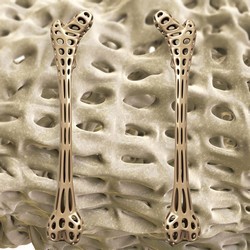Bioinspiration for broken bones
Osteoporosis and damage caused by metastatic cancers are imposing a heavy burden on an ageing Europe. The EU-funded INNOVABONE(opens in new window) (Novel biomimetic strategy for bone regeneration) project has developed optimal materials that mimic the natural bone repair process. Smart bioactive scaffolds in the bone lesion host genetically-engineered elastin-like polymers with a molecular architecture for cell attachment, growth factors and calcium phosphate nanoparticles. The biocompatible injectable material based on recombinant elastin-like proteins is liquid at low temperatures and sets into a gel at body temperature. The proteins contain cell adhesion sequences and growth factors with controlled amounts of calcium phosphate nanoparticles altogether enhancing bone repair and healing. The researchers successfully synthesised 2-photon polymerised biodegradable scaffolds. INNOVABONE tested the quality of four different scaffold polymer combinations using a low cost bioreactor in long-term cell culture applying dynamic mechanical analysis. The team also developed an app for data sample lifecycle management to track the scientific experiments. A fully integrated platform was developed for testing real time in vitro degradation and in vitro and in vivo bone repair and healing. In vivo models evaluated immune and inflammatory foreign body responses to biomaterials. Results showed that the gel and scaffold materials do not induce foreign body reactions. The scaffold materials induced minimal inflammation and fibrosis, meaning they would be good candidates for bone studies. Training was a key component of the project, which promoted discussions between stakeholders and researchers in Europe. Regulatory guidance was provided to ensure progress beyond the life of the project on the basis of achievements during the life of the INNOVABONE initiative. The combination of engineering techniques, materials science and cell biology expertise has already produced a vast amount of information on biomaterials for the new medical device. The INNOVABONE product promises to alleviate the huge social and economic strain caused by bone lesions mainly as a result of osteoporosis. Inclusion of industrial partners in the consortium could lead to rapid commercialisation.







